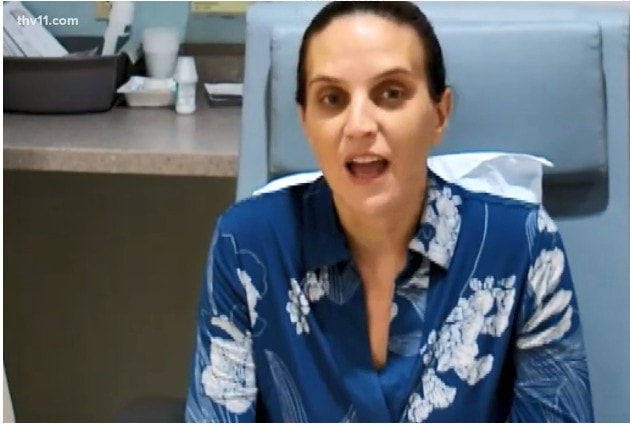View Larger Image

Tara Farris in her hospital room after her surgery
Woman Undergoes Successful Liver Transplant at UAMS During Pandemic
| Seven years ago, Tara Farris of Little Rock went to a dermatologist to try to figure out why she was itching so much. But the cause of the uncomfortable sensations wasn’t readily apparent.
Finally, after a battery of tests and biopsies, “they found out my liver was way out of whack,” she said.
The diagnosis: primary sclerosing cholangitis, a chronic liver disease that slowly damages the bile ducts, which become blocked due to inflammation and scarring. Sometimes higher levels of bile salt accumulates under the skin, causing itching.
Gradually, as cirrhosis progresses and the amount of scar tissue in the liver increases, the liver slowly loses its ability to function.
“The doctor told me I had five to 10 years before I had to have a liver transplant,” said Farris, the mother of three daughters, the youngest of whom was then in the first grade.
When initially diagnosed, her liver disease was at Stage 3. By January of this year, her condition had worsened to Stage 4, and she was placed on a waiting list for a liver transplant.
Nothing happened for a few months, but by August, she started receiving calls notifying her to be prepared since she was now a back-up for other people who were higher up on the list.
Finally, at 10 a.m. on Sept. 24, a Friday, “I was at the clinic to get a flu shot, and they called. I said, ‘Am I a back-up?’ and they said ‘No, it’s your liver.’ I called my husband at work and said, ‘This is it!’”
The hours moved slowly that day as she went ahead and got her flu shot and then waited. And waited.
“We didn’t find out until 7:45 p.m. that I was actually getting it,” she said, explaining that final tests and preparations had to be done to ensure the transplant would work.
Her surgery, performed by UAMS transplant surgeon Lyle Burdine, M.D., and his team, didn’t start until shortly before 10 p.m. — 12 hours after she had first received the call. The surgery wrapped up at about 3:30 a.m. Sept. 25.
Because of precautions in place at UAMS to protect against COVID-19, Farris’ husband of 19 years, Ryan, was unable to be present when she began waking up from the surgery at about 4 a.m.
She really wanted to see him, but, “I knew there were going to be some hurdles,” because of the pandemic, she said.
Being chronically ill during a pandemic requires extra precautions, she said.
Her husband and daughters – the youngest now in the 8th grade – joined her in being extra careful throughout the pandemic, getting vaccinated and regularly wearing masks “everywhere,” Farris said. She had also had her COVID booster vaccine, so, “I wasn’t nervous about COVID,” despite knowing COVID patients were in the hospital.
Farris was able to go home Sept. 29, just four days after the liver transplant. She said she expects to “just stay home and chill for a long time,” except for doctor visits at least twice a week for several months.
“She is currently progressing as planned,” Burdine said.
Asked about the worries of having a chronic illness and going through a transplant during a pandemic, Farris said, “I would highly recommend that people get vaccinated. It could totally save their lives. It saved my life.”
During an interview from her UAMS hospital room just three days after receiving her new liver, Farris said she’d had a talk with her family and everyone has decided to be organ donors.
“I’m very thankful for the donor for me,” she said. “That family gave up a lot to give me a new life.”
“When I found out about this, my youngest was in first grade, and she’s now in the eighth grade,” Farris said. “My two older daughters are now in college. I hope that now I will be able to live to see them all get married and have kids.”

